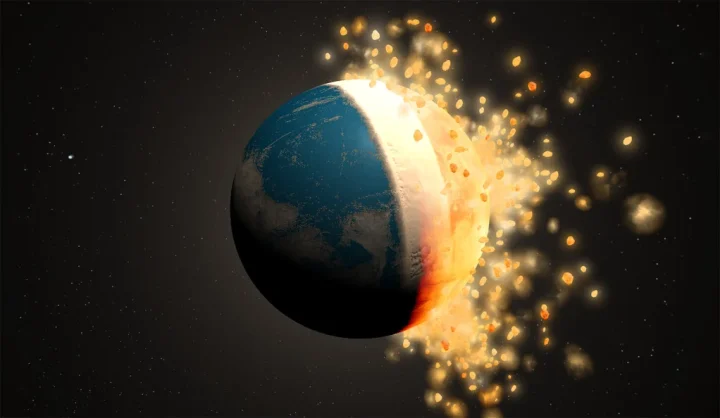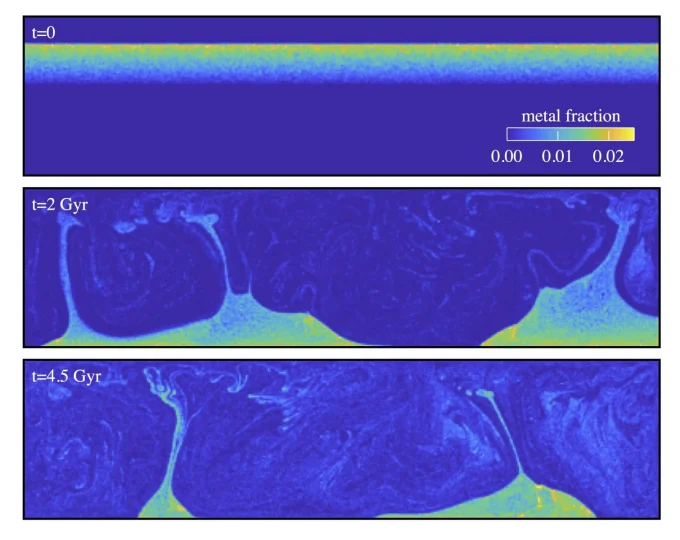New research offers a theory on how gold, platinum, and other precious metals found their way to shallow pockets within Earth’s mantle.

Artistic rendering of a large collision on the early Earth, with gold and other precious metals finding their way to the mantle of our planet. Image credit: SwRI/Marchi
Scientists at Yale and the Southwest Research Institute (SRI) say they’ve hit the jackpot with
some valuable new information about the story of gold.
The story begins with violent collisions of large objects in space, continues in a half-melted region of Earth’s mantle, and ends with precious metals (gold, platinum, and others) finding an unlikely resting spot much closer to the planet’s surface than scientists would have predicted.
Jun Korenaga, a professor of Earth and planetary sciences in Yale’s Faculty of Arts and Sciences, and Simone Marchi, a researcher at SRI in Boulder, Colorado, provide details in a study in the journal Proceedings of the National Academy of Sciences.
Their new theory provides possible answers to lingering questions about the way gold, platinum, and other precious metals found their way to shallow pockets within Earth’s mantle rather than deep in the planet’s core. More broadly, the new theory offers insights into planet formation throughout the universe.
“Our research is a good example of making an unexpected discovery after re-examining conventional wisdom,” Korenaga said.
Recent research from scientists around the world has established that precious metals such as gold and platinum came to Earth billions of years ago after the early proto-Earth collided with large, moon-sized bodies in space, which left behind deposits of materials that were folded into what is today’s Earth.
But that absorption process has remained something of a mystery.

Snapshots from mixing simulation in Earth’s mantle, from right after an impact (top) to present (bottom). Image credit: Yale/Korenaga
Aside from being valued for their scarcity, aesthetic beauty, and use in high-tech products, gold and platinum are what is known as highly “siderophile” elements. They are drawn to the element iron to such a degree that they would be expected to collect almost entirely in Earth’s metallic core — either by merging directly with the metal core on impact or by sinking quickly from the mantle into the core.
By this logic, they should not have collected at or near the Earth’s surface. Yet they did.
“Working with Simone, who is an expert on impact dynamics, I was able to come up with a novel solution to this conundrum,” Korenaga said.
Korenaga and Marchi’s theory centers around a thin, “transient” region of the mantle, where the shallow part of the mantle melts and the deeper part remains solid. The researchers found that this region has peculiar dynamic properties that can efficiently trap falling metallic components and slowly deliver them to the rest of the mantle.

Earth rising. Apollo 8 pilot Bill Anders took this iconic photo of Earth from lunar orbit on December 24, 1968. Image credit: NASA
Their theory posits that this delivery is still ongoing, with the remnants of the transient region appearing as “large low-shear-velocity provinces” — well-known geophysical anomalies in the deep mantle.
“This transient region almost always forms when a big impactor hits the early Earth, making our theory quite robust,” Marchi said.
The researchers said the new theory not only explains previously enigmatic aspects of Earth’s geochemical and geophysical evolution, but also highlights the wide range of time scales involved in Earth’s formation.
“One of the remarkable things we found was that the dynamics of the transient mantle region take place in a very short amount of time — about a day — yet its influence on subsequent Earth evolution has lasted a few billion years,” Korenaga said.
Source: Yale University

